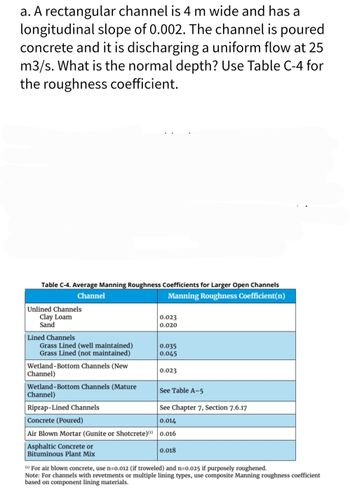
Structural Analysis
6th Edition
ISBN: 9781337630931
Author: KASSIMALI, Aslam.
Publisher: Cengage,
expand_more
expand_more
format_list_bulleted
Question

Transcribed Image Text:a. A rectangular channel is 4 m wide and has a
longitudinal slope of 0.002. The channel is poured
concrete and it is discharging a uniform flow at 25
m3/s. What is the normal depth? Use Table C-4 for
the roughness coefficient.
Table C-4. Average Manning Roughness Coefficients for Larger Open Channels
Channel
Manning Roughness Coefficient(n)
Unlined Channels
Clay Loam
Sand
Lined Channels
Grass Lined (well maintained)
Grass Lined (not maintained)
Wetland-Bottom Channels (New
Channel)
0.023
0.020
0.035
0.045
0.023
Wetland-Bottom Channels (Mature
Channel)
See Table A-5
Riprap-Lined Channels
See Chapter 7, Section 7.6.17
Concrete (Poured)
0.014
Air Blown Mortar (Gunite or Shotcrete)(¹) 0.016
Asphaltic Concrete or
Bituminous Plant Mix
0.018
(¹) For air blown concrete, use n=0.012 (if troweled) and n=0.025 if purposely roughened.
Note: For channels with revetments or multiple lining types, use composite Manning roughness coefficient
based on component lining materials.
Expert Solution
This question has been solved!
Explore an expertly crafted, step-by-step solution for a thorough understanding of key concepts.
Step by stepSolved in 4 steps with 3 images

Knowledge Booster
Similar questions
Recommended textbooks for you

 Structural Analysis (10th Edition)Civil EngineeringISBN:9780134610672Author:Russell C. HibbelerPublisher:PEARSON
Structural Analysis (10th Edition)Civil EngineeringISBN:9780134610672Author:Russell C. HibbelerPublisher:PEARSON Principles of Foundation Engineering (MindTap Cou...Civil EngineeringISBN:9781337705028Author:Braja M. Das, Nagaratnam SivakuganPublisher:Cengage Learning
Principles of Foundation Engineering (MindTap Cou...Civil EngineeringISBN:9781337705028Author:Braja M. Das, Nagaratnam SivakuganPublisher:Cengage Learning Fundamentals of Structural AnalysisCivil EngineeringISBN:9780073398006Author:Kenneth M. Leet Emeritus, Chia-Ming Uang, Joel LanningPublisher:McGraw-Hill Education
Fundamentals of Structural AnalysisCivil EngineeringISBN:9780073398006Author:Kenneth M. Leet Emeritus, Chia-Ming Uang, Joel LanningPublisher:McGraw-Hill Education
 Traffic and Highway EngineeringCivil EngineeringISBN:9781305156241Author:Garber, Nicholas J.Publisher:Cengage Learning
Traffic and Highway EngineeringCivil EngineeringISBN:9781305156241Author:Garber, Nicholas J.Publisher:Cengage Learning


Structural Analysis (10th Edition)
Civil Engineering
ISBN:9780134610672
Author:Russell C. Hibbeler
Publisher:PEARSON

Principles of Foundation Engineering (MindTap Cou...
Civil Engineering
ISBN:9781337705028
Author:Braja M. Das, Nagaratnam Sivakugan
Publisher:Cengage Learning

Fundamentals of Structural Analysis
Civil Engineering
ISBN:9780073398006
Author:Kenneth M. Leet Emeritus, Chia-Ming Uang, Joel Lanning
Publisher:McGraw-Hill Education


Traffic and Highway Engineering
Civil Engineering
ISBN:9781305156241
Author:Garber, Nicholas J.
Publisher:Cengage Learning